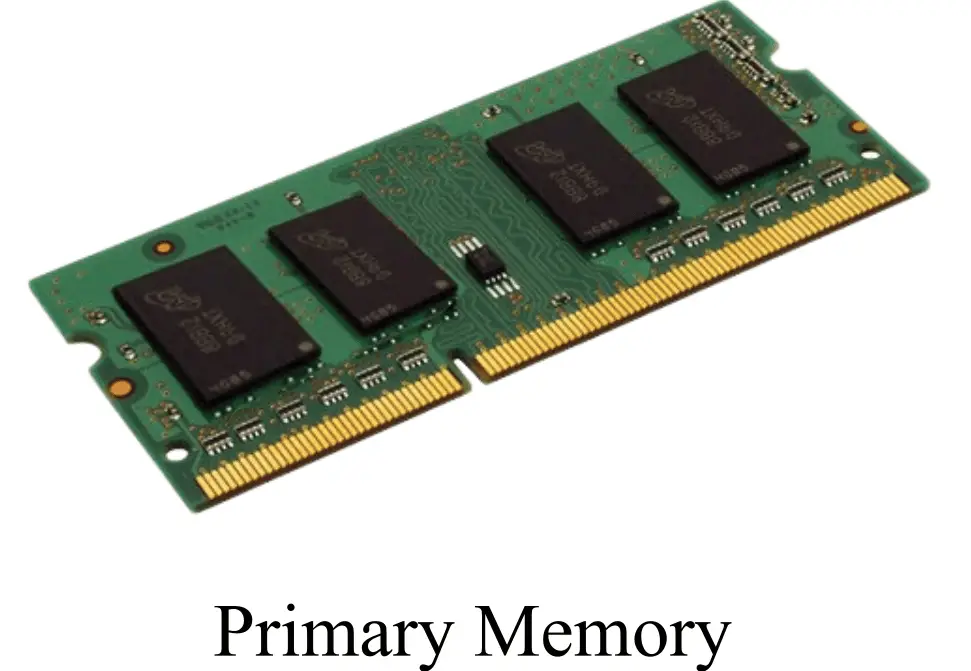In this article, we shall discuss the key differences between primary memory and secondary memory. In computers, memory is the place where all the data, information, and instructions are to be stored.
Depending on the purpose, memory is categorized into two types: primary and secondary. The fundamental difference between primary and secondary memory is that the primary memory is directly accessible to the CPU, while, the CPU accesses the secondary memory via primary memory.
Before going into the differentiation of primary memory and secondary memory, let us first discuss the basics of primary memory and secondary memory individually.
What is Primary Memory?
Primary memory is a type of computer memory that is used to store the data and instructions on which the CPU is currently working. It is also known as the main memory. Sometimes, it is also called the internal memory of the computer. Since data stored in primary memory is directly accessible to the CPU, thus it is used to store data that have to be currently processed. Primary memory is generally made up of semiconductor material and connected to the computer on the motherboard. It is faster memory.

Primary memory is classified into two types namely, RAM (Random Access Memory) and ROM (Read Only Memory). RAM is a temporary memory used to store in-process data and instructions, whereas ROM is a permanent memory used to store data like BIOS. Primary memory is relatively expensive and hence build in smaller capacities.
Examples of primary memories are RAM, ROM, Cache memory, PROM, EPROM, Registers, etc.
What is Secondary Memory?
Secondary memory is another type of computer memory. This memory is used to store data that are not to be currently executed but are required for future use. Secondary memories are primarily developed to overcome the problems associated with primary memory such as high cost, smaller size, temporary data storage, etc.

Secondary memories are always permanent, and they are generally made up of magnetic materials, optical materials, and semiconductor materials. However, this memory is slower in speed because the CPU cannot directly access its data. In secondary memory, data is first copied to primary memory, then only the CPU can use it.
Examples of secondary memories are CDs, DVDs, HDDs, SSDs, Pen Drives, SD cards, etc.
Now, we have enough knowledge about primary memory and secondary memory. So let’s discuss the differences between them.
Differences between Primary Memory and Secondary Memory
The key differences between primary memory and secondary memory are listed in the following table:
| Key | Primary Memory | Secondary Memory |
| Definition | Memory that is directly accessible to the processor is referred to as primary memory. | Memory that can not be directly accessed by the processor is called secondary memory. |
| Another name | Primary also known as main memory. | Secondary memory is also known as auxiliary memory. |
| Data stored | It stores data and instructions required for ongoing processing. | It stores data and instructions required for permanent storage and future use. |
| Nature | Primary memory is temporary and permanent in nature. | Secondary memory is always permanent in nature. |
| Made up of | Primary memory is made up of semiconductor materials. | Secondary memory is made up of magnetic materials, optical materials, and semiconductor materials. |
| Speed | Primary memory is faster. | Secondary memory is slower. |
| Capacity | Primary memory has less capacity. | Secondary memory has a larger capacity. |
| Cost | Primary memory is expensive. | Secondary memory is less expensive. |
| Examples | RAM and ROM are examples of primary memory. | CD, DVD, Pen drive, HDD, SSD, etc. are examples of secondary memory. |
| Significance | A computer cannot work without primary memory. Hence, it is a necessary memory in a computer system. | A computer can work even without secondary memory. It is just required to store data permanently. |
Conclusion
In conclusion, this is all about the differences between primary and secondary memory in computers. Primary and secondary memory do the same task, i.e. storage of data, but they are absolutely different from each other as described in the above comparison table.